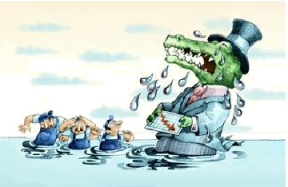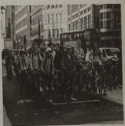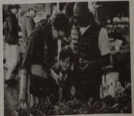| Islands that could disappear in your lifetime Island vacations are dreams for many tourists, but climate change has lifted ocean temperatures, raised sea levels and worsened storm severity. As a result, some islands are threatened and could disappear in the coming decades. | |
| Federal States of Micronesia 2019 Population: 112,640 The average rate of sea-level rise worldwide has been 3.1 mm per year since 1993. But the rate around Federated States of Micronesia is three times faster. The country is at risk of disappearing because of coastal flooding, erosion, and frequent storms. | Tuvalu 2019 Population: 11,508. Tuvalu is a small chain of islands in the Pacific Ocean. For more than 25 years, its representatives have raised alarms that climate change could raise sea levels enough to flood the islands. Even if waters never get that high, Tuvalu could still become uninhabitable as rising sea levels have polluted the nation’s groundwater resources with salt. |
| Marshall Islands 2019 Population: 58413 Residents of Marshall Islands, a chain of volcanic islands and coral atolls in the central Pacific Ocean, have known for years that they have to either build new artificial islands to relocate or raise the existing ones. | Shishmaref Alaska 2019 Population: 617 In 2016, people living in Shishmaref, Alaska, located near the Bering Strait, voted to relocate before melting ice and land erosion would forced them to. Alaska had granted the city $8 million toward the move, but officials say it will cost $200 million. |
1. The sea level around Federal States of Micronesia is rising as much as ______ or so a year.
| A.1.1 mm | B.3.1 mm | C.6.6 mm | D.9.3 mm |
| A.Federal States of Micronesia | B.Tuvalu |
| C.Marshall Islands | D.Shishmaref |

The term “crocodile tears” refers to insincere sadness. This term has an etymology dating back several centuries. As early as the fourth century, crocodile tears are referenced in the literature with the meaning of insincere sorrow. It is said that crocodiles weep while eating their hunted animals because they are sad; however, this sadness is not honest.
The term crocodile tears became widely popular after it was documented in a fifteenth-century book titled The Voyage and Travel of Sir John Mandeville, Knight. A passage from the book reads: “These crocodiles kill men and they eat them weeping.”
As you may already know, crocodilians(鳄目动物) likely feel bad about little—especially feeding. However, the assumption of the crocodile-tears metaphor may be true. In a 2007 paper published in BioScience titled “Crocodile Tears: And they eat them weeping”, researchers observed 7 crocodilians in cages during feeding time at a reserve (4 caimans and 3 American alligators). The researchers observed the crocodilians outside of water at feeding stations to better find out whether tearing developed.
Five of the 7 crocodilians developed something like tears in their eyes before, during or after feeding. The researchers suggest that these crocodile tears occur because a crocodilian hisses (发出嘶嘶声) while it eats, and this hissing forces air through the spaces in the bone behind the nose and out the eye, in the process picking up nasolacrimal secretions (鼻泪管分泌物.)
In humans, crocodile tears is a medical condition that causes a person to tear up while eating. Crocodile tears typically occur because of a temporary loss of facial control due to damage of the facial nerve. Specifically, when the facial nerve grows again, it does so incorrectly thus resulting in tears during chewing food.
1. The underlined word “etymology” in Paragraph 1 refers to ________.| A.a reference book containing articles on various topics |
| B.the origin and history of a particular term |
| C.a printed sheet of paper that are given free to advertise |
| D.the application and influence of a new theory |
| A.is a medical condition that causes a crocodile to tear up |
| B.became widely popular as early as the fourth century |
| C.refers to pretended sadness |
| D.proved to be only an assumption |
| A.crocodilians especially feel bad about feeding |
| B.not all the 7 crocodilians developed tearing |
| C.the crocodilians were carefully observed inside water |
| D.crocodile tears occur because a crocodilian hisses after it eats |
| A.what the real truth is about crocodile tears |
| B.when the term “crocodile tears” got popular in literature |
| C.how researchers made the experiment on crocodilians |
| D.why crocodile tears typically occur in humans |
The call of the Wild
1. How do you find Perrault and Francois?| A.greedy and cruel | B.hard-working and determined |
| C.gentle and generous | D.shy and timid (胆怯的) |
| A.he has learnt the survival skills. |
| B.he has known what friendship is. |
| C.he has lost faith in his own ability. |
| D.he has achieved nothing in his life. |
| A.feels afraid of | B.shows no fear of | C.stands in one’s path | D.plays tricks on |
1. How long did the snow last last night?
| A.One hour. | B.Two hours. | C.Three hours. |
| A.Continue to wait for the bus. |
| B.Have a drink together. |
| C.Get on the bus. |
| A.Rain-forests. | B.Animals. | C.Weather. |
6 . For some people, walking or running outdoors is a great way to exercise. What may not be so great is seeing rubbish all over the ground. Well, some people are doing something about it.
A Swedish man named Erik Ahlström, started the movement in 2016. He moved to Stockholm from a small community (社区) in northern Sweden. Each day he would ride his bike to work. He became worried about the amount of rubbish and litter he saw each day on his way to work. So, he took matters into his own hands. He began picking up the rubbish.
Today, plogging is an official activity, which is becoming more and more popular. People of all ages are welcome to plog. Exercise while helping your community.
Along with cleaning up the environment, there may be another reason to choose plogging instead of just jogging. You may get a better workout. One fitness app, Lifesum, records one hour of plogging as burning 288 calories.
As can be seen, cities around the world now hold plogging events. The goal is to spread the idea that littering is not acceptable. People would think twice before dropping a garbage on the ground.
| A.Plogging is equal parts of exercise and community service. |
| B.And that is how plogging was born! |
| C.And plogging does good to your health. |
| D.Usual jogging burns about 235 calories. |
| E.They are plogging! |
| F.There are people all around the world doing this. |
| G.You get to know your neighbors. |
7 . I first saw a crayfish (小龙虾) around 2001. A friend brought one into the office and told me it was a female animal that was reproducing (繁殖) on its own. We realized the new type of animal was reproducing itself by the millions.
We think that in the 1990s, two crayfish got children either in a pet store or in the wild. Something went wrong and one of the daughters laid eggs without any males. It’s not unusual for such a sudden change like this to happen, but normally, the children can’t live on or reproduce, and the new type won’t spread. For some reason, this daughter and her children did.
In some way, many of the new crayfish appeared in German pet stores. They would naturally increase, and their owners would often set the children free, which let the animals reproduce and spread farther. In 2003, scientists officially proved that animals like crayfish were, in fact, reproducing themselves. They’ve gone from that single female 25 years ago to millions, or maybe billions, of the same crayfish found throughout Europe and Madagascar.
In 2018, we published a map of the clones’ genetic code (克隆类遗传密码图). This type is becoming a really useful tool for researchers like me: We can use crayfish-like animals to study everything from cancer development to the effects of drugs on the brain. Now that we know this code, we can start to try it in the lab. For example, we might try to make these animals grow to larger sizes so people can sell them for food. This is already happening in Madagascar. It turns out that crayfish are pretty tasty. It’s easy to get lots of them too because they grow up in about three months and lay hundreds of eggs. Just put one in a pool and wait.
1. What do people think happened to crayfish in the 1990s?| A.Crayfish’s children could not live on or reproduce . |
| B.Crayfish got their lives in a scientific way in the lab. |
| C.A daughter crayfish got a strange ability to reproduce. |
| D.All animals like crayfish could reproduce themselves. |
| A.The reason why crayfish became pets. | B.The place where crayfish came from. |
| C.The different ways to raise crayfish. | D.The fact of crayfish’s self-reproduction. |
① diet ② medicine ③ brain ④ ocean
| A.①② | B.③④ | C.①③ | D.②④ |
| A.a cookbook | B.a science magazine | C.an advertisement | D.a guide brochure |
8 . Sometimes it can be easy to become too satisfied when it comes to living sustainably. We may all have recycling bins in our kitchens, but here are some ways you can live more sustainably.

1. Put an end to plastic water bottles and one-off coffee cups
The only way this is going to work is that if you have reusable options you really love, invest in a great water bottle. This is an advance payment, but it will save you money in the long run. A 750ml bottle of Evian costs 90p in Tesco, meaning if you buy one every two days you could save £10 within three weeks by filling up a reusable bottle at home.
2. _______________________________________

The high street is problematic on so many different levels. Not only are you buying items with questionable supply chains, but the carbon footprint of each product is shocking as well. Online shopping is even worse, with overpackaging for each item and the emissions from delivery trucks. The answer is to stick to reach-me-down or previously owned items as much as possible. Not only will this save you money, but there’s also a sense of satisfaction in finding a hidden treasure from the flea market where you find outstanding bargains or something used, which you simply can't get from shopping in Wal-Mart or on Amazon.
3. Think hard about your transportation

Even if your car is supposedly a low-emissions model, it’s still going to be a huge contribution to your carbon footprint. There are times when getting in a car can’t be avoided, but if you can substitute just one flight a year with a train, one car journey a week with a bus. and one bus a month with a bike ride, you’ll find that making more mindful transport decisions can easily make your day-to-day life more environmentally friendly with little effort.
4. Try to buy local, seasonal produce
You may think buying strawberries in December or courgettes in spring is no big deal, but the chemicals and fuel used to artificially copy the right environment for them to grow create harmful gas emissions. Similarly, the environmental impact of transporting produce from another country is huge. Buying from local farmers also means you can often ignore the huge amounts of packaging the supermarkets use.
1. According to the passage, if we want to lower our carbon footprint, we’d better ________.| A.purchase a 75ml bottle of Evian in Tesco every other day |
| B.never do some shopping in Wal-Mart or on Amazon |
| C.buy strawberries in December or courgettes in spring |
| D.take transport with a low-emissions model if possible |
| A.Avoid too much traffic on the high street. |
| B.Buy items without questionable supply chains. |
| C.Buy second-hand products as much as possible. |
| D.Avoid buying items with excessive packaging. |
9 . A recent study presents the possibility of “carbon farming” as a less risky alternative to other carbon capture and storage technologies. It suggests that a significant percentage of atmospheric CO2 could potentially be removed by planting millions of acres of a shrub known as the Barbados nut(麻疯树), in dry, coastal areas. But other experts doubted whether the Barbados nut would be able to grow well in sandy desert soils and absorb the quantity of carbon their models predict.
The researchers behind the study say Barbados nut plantations(种植园)could help to reduce the local effects of global warming in desert areas, causing a decrease in average temperature and an increase in rainfall. If a large enough portion of the Earth were blanketed with carbon farms, these local effects could become global, capturing between 17 and 25 metric tons of CO2 per hectare each year over a 20-year period.
Carbon farms would not compete with food production if they were concentrated in dry coastal areas. In their analysis, oceanside desalination(海水淡化)plants provide a low-emission irrigation method. The study states that the Barbados nut is uniquely suited to growing in regions unsuitable for other crops .The plant, which produces a non-edible seed that can be used to create biodiesel(生物柴油), is comfortable growing at temperatures exceeding 100 degrees Fahrenheit. It can also stand up to high levels of pollution in the soil, making waste water another potential source for irrigation.
The cost of carbon farming is comparable to the costs associated with other carbon capture and storage technologies, the study claims. Wulfmeyer stressed that carbon farming could have “fantastic value for the local people” if international carbon markets pick up, promoting rural development and opening up the possibility of additional agriculture as the soil quality improves around the plantation.
In an email, Van Noordwijk, a chief science advisor, questioned the growth rate and the atmospheric carbon capture rate assumed by the study's authors, calling the estimated carbon price of the plantations a “considerable underestimate”. “We are talking about a plant with a shrubby growth habit and a long track record of misleading farmers with production potentials that are not being realized,” he said, and “Even with abundant water, the nutrient storage in sandy desert soil is low. He added, “The estimated carbon price of this option already indicates that there are far better opportunities for reducing ongoing emissions from peatland(泥炭地)use and deforestation.”
1. In the opinion of researches behind the study, all of the following will happen EXPECT ________.| A.an increase of rain | B.a drop in temperature |
| C.the reduction of soil pollution | D.the relief of global warming |
| A.The eatable seeds of the tree. | B.High temperature resistant. |
| C.Biological sources of energy. | D.Adaptability to dirty water. |
| A.Interested. | B.Positive. | C.Indifferent. | D.Critical. |
10 . It is easy to miss amid the day-to-day headlines of global economic recession, but there is a less obvious kind of social upheaval(剧变)underway that is fast changing both the face of the planet and the way human beings live. That change is the rapid growth in urbanization. In 2008, for the first time in human history, more than half the world’s population was living in towns and cities. And as a recently published paper shows, the process of urbanization will only accelerate in the decades to come—with an enormous impact on biodiversity and potentially on climate change.
As Karen Seto, the lead author of the paper, points out, the wave of urbanization isn’t just about the migration of people into urban environments, but about the environments themselves becoming bigger to provide enough room for all those people. The rapid expansion of urban areas will have a huge impact on biodiversity hotspots and on carbon emissions in those urban areas.
Humans are the ultimate invasive species-when they move into new territory, they often displace the wildlife that was already living there. And as land is cleared for those new cities—especially in the dense tropical forests-carbon will be released into the atmosphere as well. It’s true that as people in developing nations move from the countryside to the city, the shift may reduce the pressure on land, which could in turn be good for the environment. This is especially so in desperately poor countries, where residents in the countryside slash and burn forests each growing season to clear space for farming. But the real difference is that in developing nations, the move from rural areas to cities often leads to an accompanying increase in income—and that increase leads to an increase in the consumption of food and energy, which in turn causes a rise in carbon emissions. Getting enough to eat and enjoying the safety and comfort of living fully on the grid is certainly a good thing-but it does carry an environmental price.
The urbanization wave can’t be stopped—and it shouldn’t be. But Seto’s paper does underscore the importance of managing that transition. If we do it the right way, we can reduce urbanization’s impacts on the environment “There’s an enormous opportunity here, and a lot of pressure and responsibility to think about how we urbanize,” says Seto. “One thing that's clear is that we can’t build cities he way we have over the last couple of hundred years. The scale of this transition won’t allow that.” We’re headed towards an urban planet no matter what, but whether it becomes heaven or hell is up to us.
Title | Urbanization |
Present | Throughout the world, over half population live in urban areas with the process of urbanization still |
Characteristics | ·People ·Environments become bigger to |
Biodiversity hot-spots and carbon emissions in the areas will be | |
Means of urbanization | · ·Clear land to make · |
Conclusion | We should |



